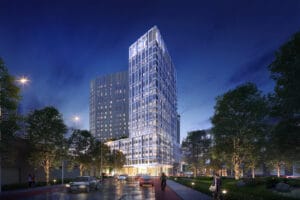
Developer John Tocco plans to build a 21-story, high-end apartment building in what’s currently a sea of low-rise industrial buildings in Everett. Image courtesy of The Architectural Team
It wasn’t all that long ago that Boston’s luxury housing ecosystem centered on Back Bay and Beacon Hill.
These days, just about everything is expensive, and residential developers often find themselves competing on the same property against life science developers who are willing to shell out a lot more to build labs.
That competition, coupled with the perennial push to find sites with access to reliable public transit, ushered in a new crop of submarkets for high-end housing – and some of the cities rising to the top these days might surprise you. Following Somerville’s lead, areas including Everett, Chelsea and East Boston are seeing their own surge of upscale new construction.
“A lot of the developments taking place are actually in newly transit-friendly areas that are within close proximity to downtown Boston and the jobs center there,” said Jeffrey Myers, Boston-based research director at Colliers International.
Everett is no longer just an industrial zone that happened to land a $2.6 billion casino resort. Developer Greystar broke ground recently on a 450-unit apartment complex on Garvey Street in Everett. Greystar’s plan is to eventually have 1,905 units across three projects.
The complex is part of Commercial Triangle, a 100-acre section of the city that Everett officials rezoned in 2018 to make way for higher-density projects. An added bonus: The area is likely to get some level of boosted transit connectivity, as studies are underway about a potential MBTA Silver Line extension through the area.
These large size of these industrial parcels makes them a blank canvas for residential developers.
“If you look at that area as an underutilized industrial part of town, well, that’s where big properties can get built,” Myers said. “It’s easier to do that on an underutilized warehouse or manufacturing site and clear it out and go residential than it is to go into the middle of a neighborhood or one of the squares and do it.”
Sky-High Ambitions for Everett
Developer John Tocco plans to build a 21-story, high-end apartment building in Commercial Triangle. That proposal, called Sky Everett, is slated to be the tallest residential building in Everett and second-tallest tower overall in the city after nearby Encore Boston Harbor. Famed local restaurateur Nick Varano is expected to open a rooftop restaurant as part of the project.
Why the Seaport-esque proposal – but at significantly lower costs than you’d find in Boston, Tocco said – in the still-industrial landscape Everett?
“There is still a huge, pent-up housing demand, and, really, the only place you can get speed to market is in these sort of Gateway Cities where the [officials] are so excited and receptive to the growth and the transformation of these tired industrial parcels,” Tocco said. “What takes a year or less to permit in Everett or Lynn or some of these other towns, you can be banging your head on the wall for five years in Boston.”
The potential transit connectivity is a key piece in moving forward with one of these higher-end residential projects. Assembly Row in Somerville took off around an infill station built on the Orange Line that was completed in tandem with the mixed-use project. The Mark, a Davis Cos. luxury condo development in East Boston, is the latest of several high-end residential projects pouring into the neighborhood.
The Davis Cos. executive team declined to speak on the record for this story, but East Boston’s transit access to downtown Boston via the MBTA Blue Line has been a major consideration in the decision of other condo and apartment developers to build there.

Greystar and Partners Group’s new 450-unit apartment project broke ground in April at 35 Garvey St. in Everett, part of the city’s transforming Commercial Triangle district where thousands of multifamily units are planned and under construction. Image courtesy of Greystar
Labs Displace Multifamily in Boston
Another factor nudging out a dense surge of residential development from Boston proper and into the surrounding inner ring of towns and cities is how competitive the broader commercial real estate market has become. Kendall Square is no longer the only life science game in town. Major projects are underway or proposed in the Seaport, South Boston, the South End and Roxbury.
While not every available plot of land is conducive for life science development, that doesn’t keep many developers from trying to shoehorn in a lab or research and development project – and pay top dollar in the process.
A prime example of this is found in the Seaport, where WS Development has asked city leaders for permission to convert some planned residential projects or pushed them out to later phases and brought in more life science-oriented buildings earlier for the ongoing buildout of the neighborhood.
“There are certainly parts of town where, if you had residential on the books and you’re competing with a lab development and lab is able to pay more for that site or pay more in rent, then you’re considering lab over residential,” Myers said.
But if Greater Boston’s life science real estate appetite is so insatiable, what’s keeping these newer residential hot spots from seeing a similar shift in demand to lab?
“It’s not that it’s necessarily one-for-one at every site where it’s either lab or residential, whichever one pays more,” Myers said. “In some neighborhoods or jurisdictions, it’s zoned for [a certain project type] and it’s going to stay that way, or this is the direction they’re going per their master plans. So, you’re not going to necessarily have that competition for every site.”
The ultimate factor is securing financing to move any of these projects forward. Finding a lender who buys into the long-term development trajectory of some of these industrial areas isn’t a small task, Tocco said. It takes time to convince those who control the purse strings that Boston isn’t just limited to Back Bay, Beacon Hill, and the Seaport when it comes to desirable places to live – and that areas like East Boston, Chelsea and Everett aren’t so far off the beaten path.
“The local equity still sees it as Everett, and they’re bound by these old biases,” Tocco said. “You get folks from New York and Chicago and other areas, and they see it as, ‘Oh, my gosh, look at this. It’s a mile from the heart of Boston. It’s amazing.’ So, I think that having fresh capital that sees the place for its potential versus a bunch of people straddled with old biases has helped significantly as well.”




